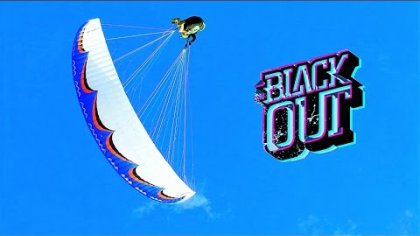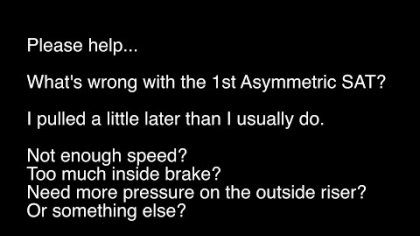19 years ago
This trick was invented by Raul Rodriguez in 2000. It’s a SAT, leaded in from an Asymmetric Spiral. The axle of the rotation is steep (could be around 135 degrees), so the pilot swings above and under the level of the glider. Normally the energy run out after few turns. The Asymmetric SAT is a perfect practice for the Tumbling, so if you want to learn that, you have to master this trick! During this manouvre you can experience 3-4 positive G’s, so it’s also great to get to know and get used to these higher loadings.
Enter:
Build up a dynamic and well timed Asymmetric Spiral to the right. After you pass the highest point in the last asymmetric turn, grab the left riser, quickly take a wrap on the right brake (if it’s needed to enter a SAT normally), and pull a SAT to the right with extremely weight shifting, at the same moment you would make the next asymmetric turn (when you are straight under the glider). You should pull in the brake quickly and hard, but be careful, don’t do a MacTwist unintended!
When you try this manouvre at first, start weight shifting and braking before you reach the lowest point. By this the Asymmetric SAT won’t be so high, but more dynamic and safer. Than you can start it later and later to make it higher.
Or
You can also enter from a Wing-Over with the same technique, but only to the same side as you did the last turn! If you do it to the opposite side that would be more like a Tumbling! Acutally there’s more energy in an Asymmetric Spiral, than in a Wing-Over, so it’s better to choose the first way. Don’t forget: speed = safety.
Advanced technique:
It’s possible to keep the energy of the Asymmetric SAT for few more turns by rhythmical braking. Pull more right brake immediately when you start to swing above the glider again (at the moment you feel the highest G-Force), and release it on the opposite side of the turn.
If your timing is bad, the Asymmetric SAT will transform into a simple SAT, instead of keep it’s energy or even getting higher.
Exit:
Depends on the height of the Asymmetric SAT, you can exit 2 different ways:
If the Asymmetric SAT is not soo high, the movement will transform into a simple SAT just by keeping the brake (you can help it by pulling it a little bit deeper as the energy run out). So in this case, lead it out as a SAT. However you doesn’t swing above the glider anymore, you’ll feel it pulsing a little bit in each turn!
If the amplitude is bigger (the angle is around 135 degrees or even more) you have to brake the glider to stop the rotation, just like in a Tumbling. Usually you can do 2-3 turns safe, depend on your technique and the type of the glider. I advise to exit these kind of Asymmetric SATs after 2 turns at the beginning. Than later if your technique is advanced and you’re sure there’s enough energy for more rotation(s), you can keep on the manovure.
Look at your glider. During the Asymmetric SAT, as you are swinging above and below the level of the glider, the canopy looks under the over the horizon from the inside (you see the ground and the sky behind the glider . At the end of the second turn, when the glider would reach the horizon (and starts to shoot below you for the third time), stop it by both brakes to exit the Asymmetric SAT. Actually you already brake the right side pretty hard, so you need to pull down only the left one (but sometimes strongly!). Release the brakes as the glider stops in front and you start to swing back under the wing.
Dangers!
The most important thing is the right timing of the exit. Don’t try this manouvre until you can imagine absolutely clearly what will you see from the inside, (anyway it concern to all aerobatics manouvre!), otherwise you can easily loose the orientation and you wouldn’t know what and when to do. If you don’t stop the glider in time, and it starts another turn without enough speed, the energy could run out when you’re over the glider, and you can get a huge collapse and fall down next to the canopy or even into the lines!
Because of the big pendulum it’s more difficult to pull a negative at the enter, but be careful, don’t do a big MacTwist unintented!
During this manouvre the glider is under extremely increased loading. Make sure your glider’s condition is good enough to stand out these high G’s, otherwise the lines and even some parts of the canopy can break! It’s also not much fun if your brakeline gone in the middle of the manouvre… In this case you manage to stabilize the glider, go to land as soon as possible using the „D” riser. If one of the „A” or „B” lines break, the loading on the rest will increases and many others will follow. If the canopy is not safely steerable anymore, don’t hesitate to throw your reserve!








Latest Comments
video still not working...
Thanks for your note...I don't know what's going on, funny Vimeo...I'm going to re-upload that.
Any other problems?
This video does not seem to be working for several months now. Can this be fixed? Thanx.
Has anybody some eperience on doing the asymSAT with a vulcan m?
I`m looking for some tips because for normal sat i have to pull very early and it does not work every time (outer wing collapses)...
also at asymSAT?